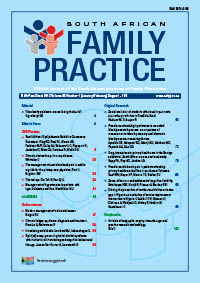The red eye
Keywords:
Red eye, primary health care, conjunctivitis, keratitis, scleritis
Abstract
The red eye is a clinical problem that is encountered regularly in most primary healthcare settings. A wide spectrum of diseases may cause a red eye. Fortunately, most are relatively benign, but many potentially sight-threatening conditions may manifest in a similar way. From the history and examination, the primary care physician must be able to differentiate between features that make primary care treatment possible and high-risk features that necessitate immediate referral. This article includes a discussion on features that distinguish benign from sight-threatening causes of red eye. Unilateral red eye, pain (a deep ache), deep redness, decreased visual acuity and photophobia signify more sinister causes. The red eye has an extensive differential diagnosis. Some of the common causes are conjunctivitis, subconjunctival haemorrhage, episcleritis, scleritis, anterior uveitis and acute glaucoma. Generally, patients who present with red eye can be divided into two groups: those who can be treated at primary care level and those who need secondary or tertiary level care. Other distinguishing features include a pattern to the redness, the type of discharge, the presence of increased lacrimation and photophobia, as well as corneal haze. However, these are not always easily employed as differentiating factors. Therefore, this article lists specific and basic features which can be used to identify the various causes of the red eye.- Figure 2. Blepharitis with visible crusting
- Figure 4. Follicles of the conjunctiva
- Figure 3. Papillae under the upper lid
- Figure 5. Copious, frothy discharge from Gonococcus
- Figure 6. Episcleritis
- Figure 7. Pterygium
- Figure 8. Squamous carcinoma of conjunctiva
- Figure 9. Herpetic 'Dendrite'
- Figure 10. Corneal scarring and vascularisation
- Figure 11. Bacterial keratitis with hypopyon
- Figure 12. Geographic ulcer
- Figure 13. Ciliary flush
- Figure 14. Diffuse scleritis
- Figure 15. Acute closed angle glaucoma
- Figure 16. Blebitis after glaucoma surgery
- Figure 17. Endophthalmitis
- Title Page
Published
2012-10-05
Section
CPD
By submitting manuscripts to SAFP, authors of original articles are assigning copyright to the South African Academy of Family Physicians. Copyright of review articles are assigned to the Publisher, Medpharm Publications (Pty) Ltd, unless otherwise specified. Authors may use their own work after publication without written permission, provided they acknowledge the original source. Individuals and academic institutions may freely copy and distribute articles published in SAFP for educational and research purposes without obtaining permission.

